Abstract
Media from cultures of fibroblasts of six patients with the autosomal recessive disease Bloom syndrome (BS) and from four normal fibroblast strains were analyzed for clastogenic activity towards phytohemagglutinin-stimulated human blood lymphocytes from healthy donors. Clastogenic activity was detected in concentrated ultrafiltrates of media from all six BS strains but none of the normal fibroblast strains. The frequencies of chromosomal aberrations that were induced depended on the concentration of the ultrafiltrates. Addition of bovine superoxide dismutase to the blood lymphocyte cultures strongly suppressed the clastogenic potency of the ultrafiltrates. Unconcentrated conditioned BS media were inactive. From the pore size of the ultrafilters and Sephadex G-10 chromatography it is concluded that the clastogenic material is in the molecular weight range of 1000 to 10,000. The concentrated ultrafiltrates of BS culture media also possessed the capacity to induce sister chromatid exchanges in normal human blood lymphocytes, but with relatively low efficiency. On the basis of these results and by analogy to certain collagen diseases such as systemic lupus erythematosus, we speculate that BS cells are deficient in the detoxification of active oxygen species.
Full text
PDF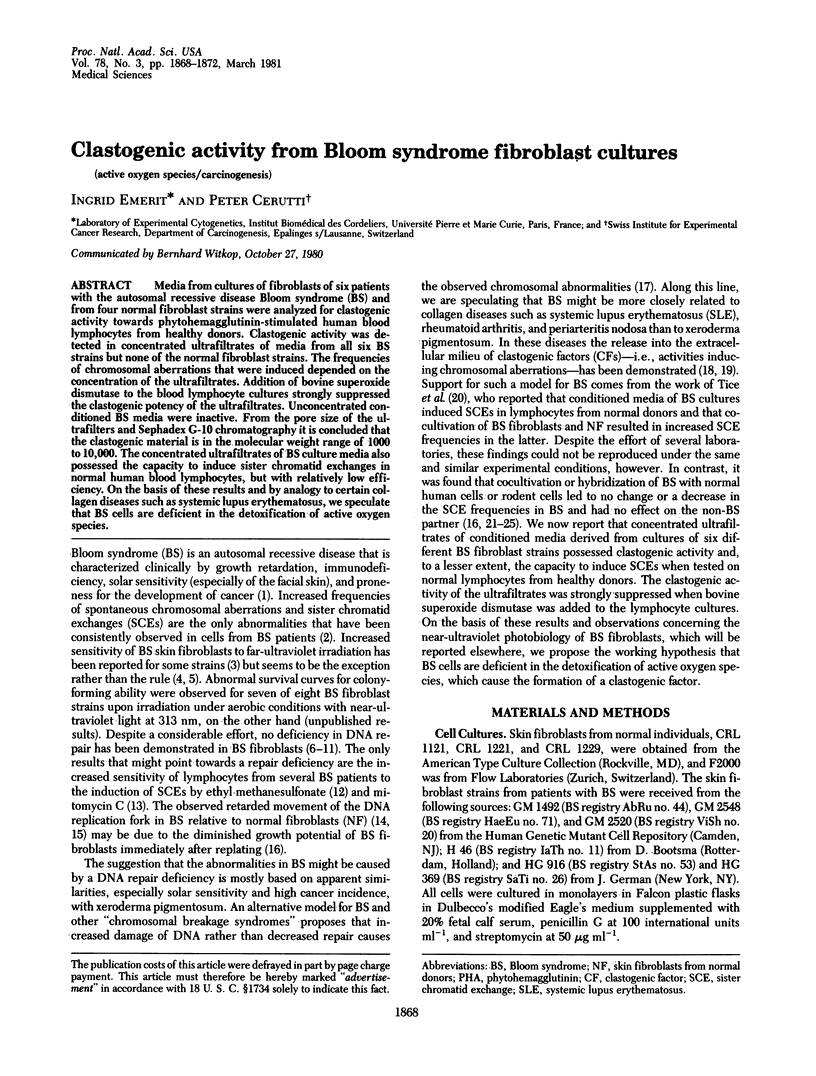
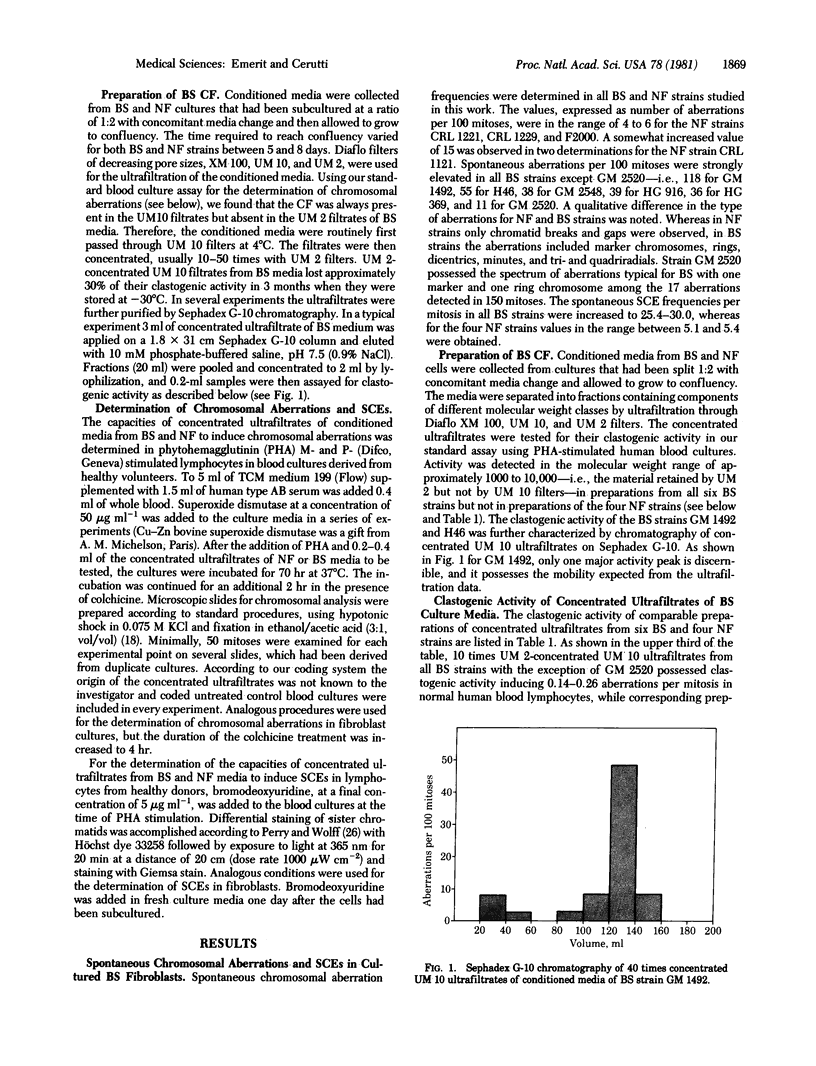
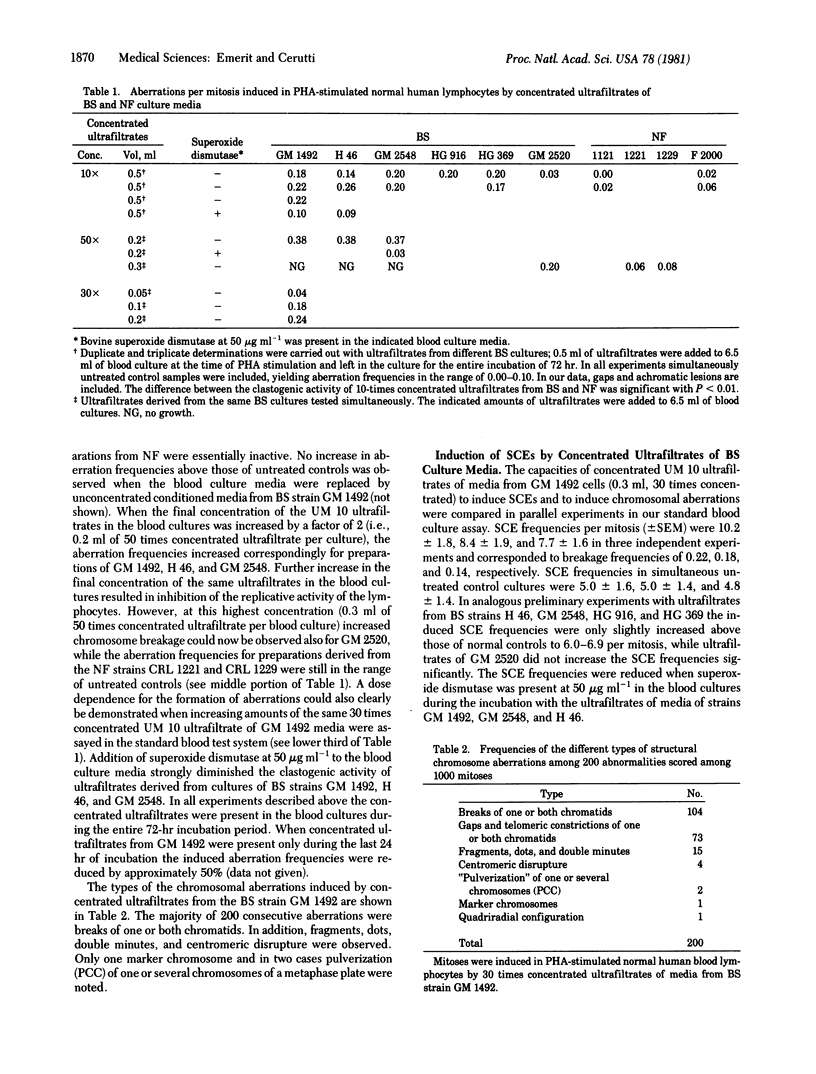
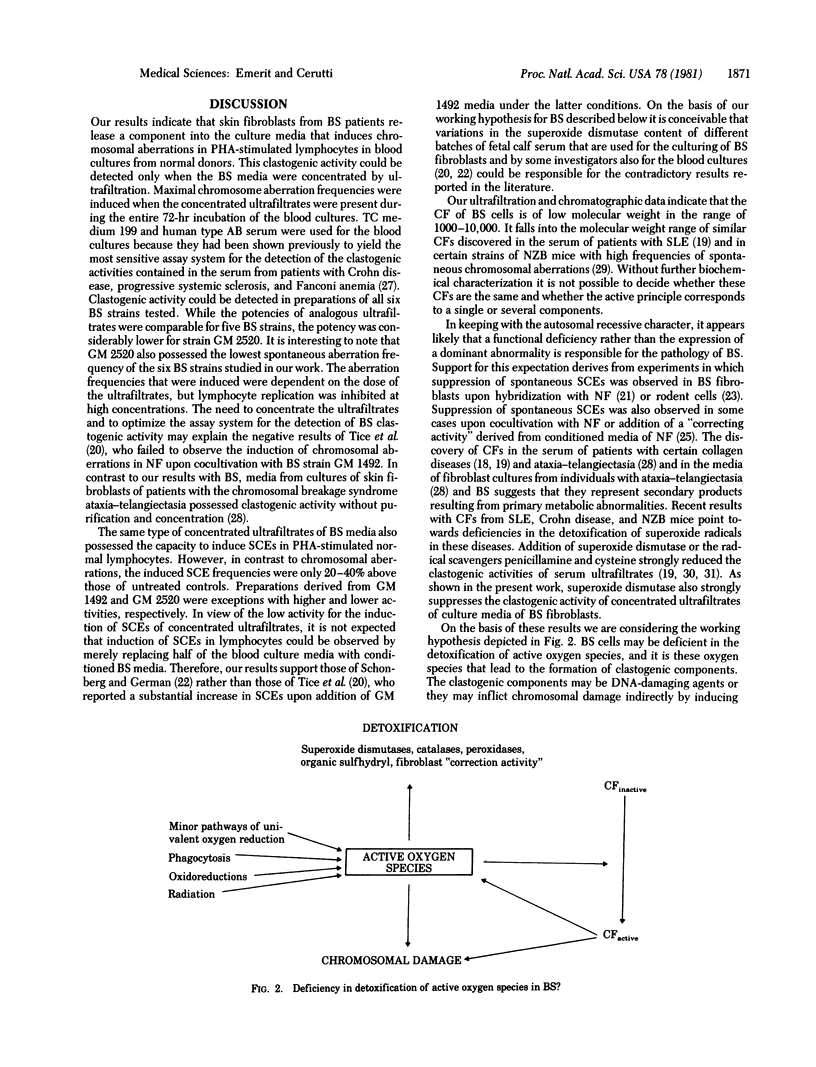
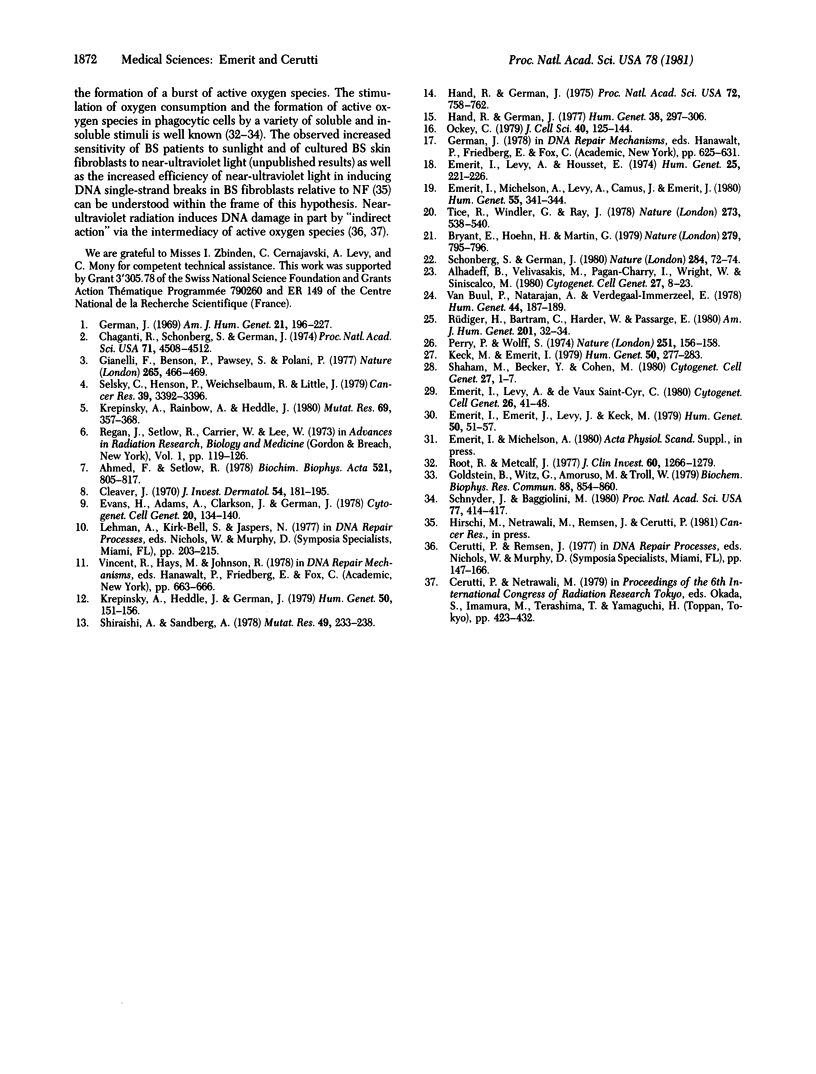
Images in this article
Selected References
These references are in PubMed. This may not be the complete list of references from this article.
- Ahmed F. E., Setlow R. B. Excision repair in ataxia telangiectasia, Fanconi's anemia, Cockayne syndrome, and Bloom's syndrome after treatment with ultraviolet radiation and N-acetoxy-2-acetylaminofluorene. Biochim Biophys Acta. 1978 Dec 21;521(2):805–817. doi: 10.1016/0005-2787(78)90319-2. [DOI] [PubMed] [Google Scholar]
- Alhadeff B., Velivasakis M., Pagan-Charry I., Wright W. C., Siniscalco M. High rate of sister chromatid exchanges of Bloom's syndrome chromosomes is corrected in rodent human somatic cell hybrids. Cytogenet Cell Genet. 1980;27(1):8–23. doi: 10.1159/000131459. [DOI] [PubMed] [Google Scholar]
- Bryant E. M., Hoehn H., Martin G. M. Normalisation of sister chromatid exchange frequencies in Bloom's syndrome by euploid cell hybridisation. Nature. 1979 Jun 28;279(5716):795–796. doi: 10.1038/279795a0. [DOI] [PubMed] [Google Scholar]
- Chaganti R. S., Schonberg S., German J. A manyfold increase in sister chromatid exchanges in Bloom's syndrome lymphocytes. Proc Natl Acad Sci U S A. 1974 Nov;71(11):4508–4512. doi: 10.1073/pnas.71.11.4508. [DOI] [PMC free article] [PubMed] [Google Scholar]
- Cleaver J. E. DNA damage and repair in light-sensitive human skin disease. J Invest Dermatol. 1970 Mar;54(3):181–195. doi: 10.1111/1523-1747.ep12280225. [DOI] [PubMed] [Google Scholar]
- Emerit I., Emerit J., Levy A., Keck M. Chromosomal breakage in Crohn's disease: anticlastogenic effect of D-penicillamine and L-cysteine. Hum Genet. 1979;50(1):51–57. doi: 10.1007/BF00295589. [DOI] [PubMed] [Google Scholar]
- Emerit I., Levy A., Housset E. Breakage factor in systemic sclerosis and protector effect of L-cysteine. Humangenetik. 1974;25(3):221–226. doi: 10.1007/BF00281430. [DOI] [PubMed] [Google Scholar]
- Emerit I., Levy A., de Vaux Saint Cyr C. Chromosome damaging agent of low molecular weight in the serum of New Zealand black mice. Cytogenet Cell Genet. 1980;26(1):41–48. doi: 10.1159/000131420. [DOI] [PubMed] [Google Scholar]
- Evans H. J., Adams A. C., Clarkson J. M., German J. Chromosome aberrations and unscheduled DNA synthesis in X- and UV-irradiated lymphocytes from a boy with Bloom's syndrome and a man with xeroderma pigmentosum. Cytogenet Cell Genet. 1978;20(1-6):124–140. doi: 10.1159/000130844. [DOI] [PubMed] [Google Scholar]
- German J. Bloom's syndrome. I. Genetical and clinical observations in the first twenty-seven patients. Am J Hum Genet. 1969 Mar;21(2):196–227. [PMC free article] [PubMed] [Google Scholar]
- Gianneli F., Benson P. F., Pawsey S. A., Polani P. E. Ultraviolet light sensitivity and delayed DNA-chain maturation in Bloom's syndrome fibroblasts. Nature. 1977 Feb 3;265(5593):466–469. doi: 10.1038/265466a0. [DOI] [PubMed] [Google Scholar]
- Goldstein B. D., Witz G., Amoruso M., Troll W. Protease inhibitors antagonize the activation of polymorphonuclear leukocyte oxygen consumption. Biochem Biophys Res Commun. 1979 Jun 13;88(3):854–860. doi: 10.1016/0006-291x(79)91487-6. [DOI] [PubMed] [Google Scholar]
- Hand R., German J. A retarded rate of DNA chain growth in Bloom's syndrome. Proc Natl Acad Sci U S A. 1975 Feb;72(2):758–762. doi: 10.1073/pnas.72.2.758. [DOI] [PMC free article] [PubMed] [Google Scholar]
- Hand R., German J. Bloom's syndrome: DNA replication in cultured fibroblasts and lymphocytes. Hum Genet. 1977 Oct 14;38(3):297–306. doi: 10.1007/BF00402156. [DOI] [PubMed] [Google Scholar]
- Keck M., Emerit I. The influence of culture medium composition on the incidence of chromosomal breakage. Hum Genet. 1979 Sep;50(3):277–283. doi: 10.1007/BF00399393. [DOI] [PubMed] [Google Scholar]
- Krepinsky A. B., Heddle J. A., German J. Sensitivity of Bloom's syndrome lymphocytes to ethyl methanesulfonate. Hum Genet. 1979;50(2):151–156. doi: 10.1007/BF00390236. [DOI] [PubMed] [Google Scholar]
- Krepinsky A. B., Rainbow A. J., Heddle J. A. Studies on the ultraviolet light sensitivity of Bloom's syndrome fibroblasts. Mutat Res. 1980 Feb;69(2):357–368. doi: 10.1016/0027-5107(80)90100-1. [DOI] [PubMed] [Google Scholar]
- Ockey C. H. Quantitative replicon analysis of DNA synthesis in cancer-prone conditions and the defects in Bloom's syndrome. J Cell Sci. 1979 Dec;40:125–144. doi: 10.1242/jcs.40.1.125. [DOI] [PubMed] [Google Scholar]
- Perry P., Wolff S. New Giemsa method for the differential staining of sister chromatids. Nature. 1974 Sep 13;251(5471):156–158. doi: 10.1038/251156a0. [DOI] [PubMed] [Google Scholar]
- Root R. K., Metcalf J. A. H2O2 release from human granulocytes during phagocytosis. Relationship to superoxide anion formation and cellular catabolism of H2O2: studies with normal and cytochalasin B-treated cells. J Clin Invest. 1977 Dec;60(6):1266–1279. doi: 10.1172/JCI108886. [DOI] [PMC free article] [PubMed] [Google Scholar]
- Schnyder J., Baggiolini M. Induction of plasminogen activator secretion in macrophages by electrochemical stimulation of the hexose monophosphate shunt with methylene blue. Proc Natl Acad Sci U S A. 1980 Jan;77(1):414–417. doi: 10.1073/pnas.77.1.414. [DOI] [PMC free article] [PubMed] [Google Scholar]
- Schonberg S., German J. Sister chromatid exchange in cells metabolically coupled to Bloom's syndrome cells. Nature. 1980 Mar 6;284(5751):72–74. doi: 10.1038/284072a0. [DOI] [PubMed] [Google Scholar]
- Selsky C. A., Henson P., Weichselbaum R. R., Little J. B. Defective reactivation of ultraviolet light-irradiated herpesvirus by a Bloom's syndrome fibroblast strain. Cancer Res. 1979 Sep;39(9):3392–3396. [PubMed] [Google Scholar]
- Shiraishi Y., Sandberg A. A. Effects of mitomycin C on sister chromatid exchange in normal and Bloom's syndrome cells. Mutat Res. 1978 Feb;49(2):233–238. doi: 10.1016/0027-5107(78)90162-8. [DOI] [PubMed] [Google Scholar]
- Tice R., Windler G., Bary J. M. Effect of cocultivation on sister chromatid exchange frequencies in Bloom's syndrome and normal fibroblast cells. Nature. 1978 Jun 15;273(5663):538–540. doi: 10.1038/273538a0. [DOI] [PubMed] [Google Scholar]
- van Buul P. P., Natarajan A. T., Verdegaal-Immerzeel E. A. Suppression of the frequencies of sister chromatid exchanges in Bloom's syndrome fibroblasts by co-cultivation with Chinese hamster cells. Hum Genet. 1978 Oct 31;44(2):187–189. doi: 10.1007/BF00295412. [DOI] [PubMed] [Google Scholar]



